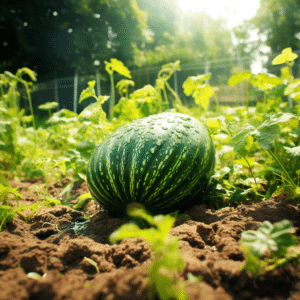Watermelon is a delicious and refreshing fruit that is loved by people all over the world. If you’ve ever wanted to try your hand at growing watermelons in your own garden, then you’ve come to the right place. In this comprehensive guide, we will cover everything you need to know about growing watermelons successfully.
Understanding the Basics of Watermelon Cultivation

Before you dive into growing watermelons, it’s important to understand the basics of their cultivation. This includes knowing about the life cycle of a watermelon plant, the ideal climate conditions for growing watermelons, and choosing the right watermelon variety for your garden.
The Life Cycle of a Watermelon Plant
Watermelons go through several stages in their life cycle. It starts with planting the seeds, followed by germination, seedling growth, flowering, fruit development, and finally, harvest. Each stage requires specific care and attention to ensure a successful harvest.
When you plant watermelon seeds, it’s important to choose a sunny spot in your garden with well-drained soil. Watermelons thrive in loose, loamy soil that is rich in organic matter. Before planting, prepare the soil by removing any weeds and adding compost or well-rotted manure to improve its fertility.
After planting the seeds, you’ll need to water them regularly to keep the soil moist. Watermelons have deep root systems, so it’s important to water deeply and avoid shallow watering. As the seedlings emerge, thin them out to ensure proper spacing between plants. This will allow each plant to have enough space to grow and develop.
Once the seedlings have grown into healthy plants, they will start to produce flowers. Watermelon flowers are typically yellow and have both male and female parts. Bees and other pollinators play a crucial role in pollinating the flowers, so it’s important to create a pollinator-friendly environment in your garden. You can do this by planting flowers that attract bees and avoiding the use of pesticides that may harm pollinators.
After successful pollination, the flowers will start to develop into small watermelon fruits. As the fruits grow, it’s important to provide support to prevent them from touching the ground. This can be done by using trellises, stakes, or slings made from old pantyhose or fabric. Supporting the fruits will prevent rotting and keep them clean.
As the watermelon fruits continue to develop, monitor them closely for any signs of pests or diseases. Common pests that can affect watermelons include aphids, cucumber beetles, and squash bugs. If you notice any pest infestations, take appropriate measures to control them, such as using organic insecticides or practicing companion planting with pest-repellent plants.
Once the watermelon fruits reach their full size and have a dull skin color, they are ready to be harvested. To determine if a watermelon is ripe, give it a gentle tap. If it sounds hollow, it’s a good indication that the fruit is ripe. Use a sharp knife or shears to cut the watermelon from the vine, leaving a short stem attached.
Ideal Climate Conditions for Growing Watermelons
Watermelons thrive in warm temperatures and require a long growing season. They need full sun exposure for at least 6-8 hours a day. The soil temperature should be around 70°F (21°C) for optimal growth. If you live in a colder region, consider starting your watermelons indoors or using black plastic mulch to raise the soil temperature.
When it comes to watering watermelon plants, it’s important to strike a balance. While they need consistent moisture, overwatering can lead to root rot and other diseases. Water deeply once or twice a week, depending on the weather conditions. Mulching around the plants can help retain moisture and suppress weed growth.
Watermelons are heavy feeders and require regular fertilization. Before planting, incorporate a balanced fertilizer into the soil. Once the plants start to grow, side-dress them with nitrogen-rich fertilizer every few weeks to promote healthy foliage and fruit development.
It’s also important to protect watermelon plants from extreme weather conditions. Strong winds can damage the plants and cause fruit drop. Consider using windbreaks or planting watermelons near a fence or wall to provide some protection. In hot climates, provide shade to prevent sunburn on the fruits.
Choosing the Right Watermelon Variety for Your Garden

Watermelons come in a variety of sizes, shapes, and colors. Some popular varieties include Charleston Gray, Sugar Baby, and Crimson Sweet. Consider the size of your garden, your climate, and the preferences of your family when choosing the right watermelon variety. You can also experiment with different varieties to enjoy a variety of flavors throughout the season.
Charleston Gray is a large, oblong watermelon with sweet and juicy flesh. It is known for its excellent disease resistance and ability to withstand hot and humid conditions. Sugar Baby, on the other hand, is a small, round watermelon that is perfect for small gardens or containers. It has a high sugar content and matures quickly, making it a popular choice for home gardeners.
If you prefer a watermelon with a crisp texture and high sugar content, consider growing Crimson Sweet. This variety produces medium to large fruits with a dark green rind and sweet, red flesh. It is a versatile watermelon that can be enjoyed fresh, in salads, or used to make refreshing summer drinks.
When planting different watermelon varieties, make sure to provide enough space between plants to prevent cross-pollination. Watermelons are open-pollinated plants, which means that their seeds can be saved and replanted. However, if different varieties cross-pollinate, the resulting fruits may have different characteristics than the parent plants.
By understanding the basics of watermelon cultivation, you can successfully grow your own juicy and delicious watermelons. Whether you’re a beginner or an experienced gardener, the joy of harvesting your own homegrown watermelons is truly rewarding. So roll up your sleeves, get your hands dirty, and start growing your own watermelons today!
Preparing Your Garden for Watermelon Planting
Before you start planting watermelon seeds, it’s important to prepare your garden to create the ideal growing conditions. This includes soil preparation techniques, proper spacing, and providing adequate watering conditions.
Soil Preparation Techniques
Watermelons prefer well-draining soil that is rich in organic matter. Before planting, amend your soil with compost or well-rotted manure to improve its fertility and drainage. Remove any weeds or rocks that might hinder watermelon growth.
Importance of Proper Spacing
Watermelon plants require ample space to grow and spread their vines. They should be planted in rows with a distance of about 6-8 feet between each plant. This allows the plants to receive adequate sunlight and air circulation, preventing diseases and promoting healthy growth.
Ideal Watering Conditions for Watermelons
Watermelons have high water requirements and need consistent watering throughout their growing season. Water deeply once or twice a week, depending on the weather conditions. Avoid overwatering as it can cause root rot. Consider using drip irrigation or a soaker hose to provide water directly to the plants’ roots.
The Planting Process: From Seed to Seedling
Now that your garden is prepared, it’s time to start planting your watermelon seeds and caring for the seedlings until they are ready for transplanting.
How to Plant Watermelon Seeds
Plant watermelon seeds directly in the garden after the danger of frost has passed and the soil temperature is consistently above 70°F (21°C). Make small mounds or hills and plant 3-5 seeds per mound. Cover the seeds with about 1 inch of soil and water gently.
Caring for Watermelon Seedlings
Once the seedlings emerge, thin them to leave only one or two of the strongest plants per mound. Water regularly and provide a light application of fertilizer every 2-3 weeks. Keep an eye out for pests and diseases and take appropriate measures to protect your seedlings.
Transplanting Seedlings to Your Garden
When the seedlings have developed 2-3 true leaves and all risk of frost has passed, it’s time to transplant them to their final position in the garden. Handle the seedlings carefully to avoid damaging the roots and plant them in the pre-dug holes at the same level as they were in the original pots. Water thoroughly after transplanting to help the plants settle into their new environment.
Maintaining Your Watermelon Garden

Now that your watermelon plants are in the ground, it’s important to maintain their health and ensure a bountiful harvest. This includes maintaining a regular watering and fertilizing schedule, managing pests and diseases, and properly pruning and training the watermelon vines.
Regular Watering and Fertilizing Schedule
Watermelons need consistent moisture to produce juicy and sweet fruits. Water deeply once or twice a week, depending on the weather conditions. During times of dry spells, increase the frequency of watering. Apply a balanced fertilizer every 3-4 weeks to provide the plants with essential nutrients for healthy growth.
Pest and Disease Management
Watermelons are susceptible to various pests and diseases, including aphids, cucumber beetles, and powdery mildew. Monitor your plants regularly and take timely action to control pests and diseases. Use organic insecticides and fungicides whenever possible to minimize the use of harmful chemicals.
Pruning and Training Watermelon Vines
Watermelon vines tend to grow vigorously and can become tangled and overcrowded. To promote better airflow and prevent diseases, prune the vines by removing any lateral branches that are competing for resources. Use trellises or stakes to train the vines vertically, which saves space and allows for easier maintenance and harvesting.
By following this comprehensive guide, you’ll be well on your way to growing delicious and juicy watermelons in your own garden. Enjoy the satisfaction of harvesting your own homegrown watermelons and impress your family and friends with your gardening skills!